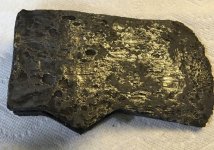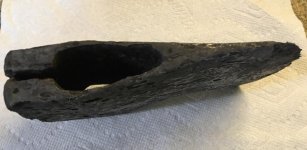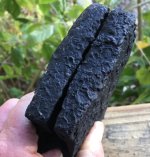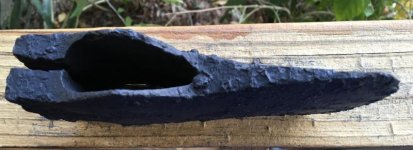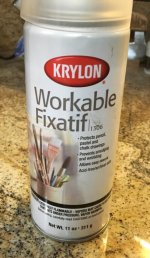You are using an out of date browser. It may not display this or other websites correctly.
You should upgrade or use an alternative browser.
You should upgrade or use an alternative browser.
Am I done?
- Thread starter Chipk
- Start date
Dirtfishn350
Forum Supporter
Looks great...
Chipk
Elite Member
Seems the rust restorative I used comes off when handled. So I found a product used to seal pencil and chalk sketches and prevents smearing at an art store. Sprayed it on lightly and no more problem.
Now I AM done.
Now I AM done.
Donneybrook
Elite Member
- Joined
- Jun 24, 2013
- Messages
- 4,340
Are you sure thats 1700s? I'm pretty darn sure its an early 1900s design. And yeah man, looks like she's good to go now!
Chipk
Elite Member
Are you sure thats 1700s? I'm pretty darn sure its an early 1900s design. And yeah man, looks like she's good to go now!
I'm pretty sure it's 1700s. First of all it was a foot deep in a spot where I have found several 1700s items, including dated coins. It was a plantation and home site of a Revolutionary Turncoat, turned pirate named Daniel McGirts. Second of all it's in the weight range for axe heads of that date. And finally it's obvious that it was anvil and forge made. They were folded in the middle and the butt was formed over a plug that served as the eye. There is a seam there.
Attachments
Chipk
Elite Member
sandgroper
Elite Member
I'm liking it! 

OP3CRIMSIN
Senior Member
Seems the rust restorative I used comes off when handled. So I found a product used to seal pencil and chalk sketches and prevents smearing at an art store. Sprayed it on lightly and no more problem.
Now I AM done.
Was it aerosolized Mod Podge or something?
Chipk
Elite Member
Was it aerosolized Mod Podge or something?
Here it is
Attachments
buttonlicker
New Member
- Joined
- Mar 18, 2017
- Messages
- 1
Rust is not your friend
I have found that on a badly rusted relic that no matter how well you think you have cleaned it there will always be pockets of insidious rust that may not be visible on the surface. Typically they can be found under the dark or black spots. I believe that you level the playing field against this cancer if you bake the iron relic for at least an hour before letting it cool down and applying whatever rust converter you choose. Moisture is one of the catalyst for oxidation and baking it will ensure that even the pockets are dry. My wife does not share my enthusiasm for iron relics so rather than use her oven I bake mine on a hot plate in the garage.
Everyone has their favorites for rust converters. Mine is Ospho.
I have found that on a badly rusted relic that no matter how well you think you have cleaned it there will always be pockets of insidious rust that may not be visible on the surface. Typically they can be found under the dark or black spots. I believe that you level the playing field against this cancer if you bake the iron relic for at least an hour before letting it cool down and applying whatever rust converter you choose. Moisture is one of the catalyst for oxidation and baking it will ensure that even the pockets are dry. My wife does not share my enthusiasm for iron relics so rather than use her oven I bake mine on a hot plate in the garage.
Everyone has their favorites for rust converters. Mine is Ospho.
Chipk
Elite Member
I have found that on a badly rusted relic that no matter how well you think you have cleaned it there will always be pockets of insidious rust that may not be visible on the surface. Typically they can be found under the dark or black spots. I believe that you level the playing field against this cancer if you bake the iron relic for at least an hour before letting it cool down and applying whatever rust converter you choose. Moisture is one of the catalyst for oxidation and baking it will ensure that even the pockets are dry. My wife does not share my enthusiasm for iron relics so rather than use her oven I bake mine on a hot plate in the garage.
Everyone has their favorites for rust converters. Mine is Ospho.
I bake mine at 300* for 30 minutes. Hopefully it's enough. Wife doesn't mind sharing the oven but she does complain about the odor that it produces.
UpStateMike
Full Member
waxes are good sealers and they keep out moisture and help slow re-tarnishing. There's one that I would highly suggest called "Renaissance Wax". It's a solvent based microcrystalline wax. If you ever want to remove it it comes off with mineral spirits/paint thinner.

https://www.theruststore.com/Renais...vnHY88bOcUFkralcn8O6808XrOO0pU8Dq6BoCq2Dw_wcB

https://www.theruststore.com/Renais...vnHY88bOcUFkralcn8O6808XrOO0pU8Dq6BoCq2Dw_wcB
I bake mine at 300* for 30 minutes. Hopefully it's enough. Wife doesn't mind sharing the oven but she does complain about the odor that it produces.
I think your wife complains about the odors you produce!! Haha. Axe looks good buddy
nickors
Full Member
coating it with wax will keep it from oxidizing.


